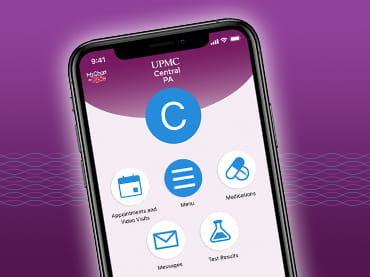Many breast cancer patients receive radiation therapy following surgery. The goal of radiation is to kill breast cancer cells that may remain even after successful surgery. This helps prevent a recurrence.
At the UPMC Breast Care Center at UPMC in Central Pa., we are striving to make radiation treatment easier for our patients. We provide eligible patients a four-week course of radiation, which has been found to be as effective as the traditional six-week course, with the same or milder side effects.
What is hypo-fractionated radiation?
Radiation treatment in which the total dose of radiation is divided into large doses and treatments are given once a day or less often. This is also called short-course breast radiation. It allows many patients to complete breast treatments in just three to four weeks rather than up to the traditional six to six-and-a-half weeks of breast radiation treatments.
A standard course of radiation therapy for breast cancer includes a daily treatment five days a week. Treatment itself usually only takes about 15 minutes each day and patients generally do not feel anything while the treatment is delivered.
However, if we can shorten treatment by 2 to 3 weeks, we’re making it much easier on the patient. There is less driving back and forth to the radiation center and patients can get on with living their lives.
Who is eligible for hypo-fractionated radiation?
In accordance with the American Society for Radiology Oncology (ASTRO) and National Comprehensive Cancer Network (NCCN) guidelines, the UPMC Breast Care Center treats women receiving whole breast radiation with short-course treatment.
Approximately 90 percent of our patients who receive whole-breast radiation following a lumpectomy receive the short course.
Not all women are eligible for this type of breast cancer treatment. Those not eligible include women for whom the regional lymph nodes are being treated, women who had a mastectomy, or women who may have some specific autoimmune conditions involving the skin. Also, some women may not be able to receive quality short-course treatment due to larger breast size or body shape.
What are other breast cancer treatment options?
We consider all factors when creating a breast cancer treatment plan specifically for each patient. We look at the type and stage of the cancer, the patient’s treatment goals, and overall health.
Based on this, we have access to a wide range of treatment tools to help patients achieve the best possible outcomes. In addition to radiation therapies, these include:
- The latest surgical approaches: This includes a lumpectomy, which removes the tumor and the tissue around it, but not the whole breast, or a mastectomy, which removes the nipple, areola and breast tissue.
- Medical therapies: This includes anti-cancer medications like chemotherapy that are used to slow or stop the growth of certain types of breast cancer.
Radiation
If radiation is deemed the appropriate treatment, my colleagues and I consider several things when planning the treatment. These include the type of breast surgery the patient received, the location of the cancer and the stage of the cancer.
Radiation treatments can include:
- Standard external beam radiation, which usually entails approximately 6 weeks of daily radiation.
- Hypo-fractionated (short-course) radiation using 3 to 4 weeks of daily radiation.
- Balloon breast brachytherapy using 1 week of twice-daily radiation.
If you need radiation treatment, talk to your doctor about short-course radiation treatment. Make sure you understand all your options.
Side Effects of Breast Cancer Radiation
The side effects of short-course radiation have been found in studies to be the same or milder than traditional longer courses of radiation treatment.
Side effects are caused by receiving multiple doses of radiation on the cells. As a result, many people don’t experience side effects until they are a few weeks into their treatment. These are usually in the area of the body that is being treated. Most are temporary.
Skin irritation, swelling in the breast, and fatigue are common short-term side effects. Long-term side effects may develop months or years after radiation therapy. They can include darkening or “tanning” of the skin, rib fracture, heart complications and swelling of the breast or arm (lymphedema). Another side effect can be radiation pneumonitis. This is a rare pneumonia-like condition caused by radiation-induced lung damage.
One way we are reducing radiation dose to the heart is by using a technique called “deep inspiration breath hold.” This involves having the patient take a deep breath and holding it for 15 to 20 seconds while they receive their radiation treatment. Taking a deep breath creates a gap between the breast radiation fields and the heart, thereby significantly reducing radiation dose to the heart.
We are also participating in a clinical trial (RADCOMP) with the University of Maryland Proton Center for patients who need nodal radiation in addition to treating the breast or chest wall. The trial is comparing if treating patients with protons vs. photon therapy helps to reduce the radiation heart dose.
Most patients tolerate radiation therapy well. Many people stay active during their treatment. UPMC Breast Care Center offers many support services to help you manage treatment side effects.
Precisely Targeted Radiation
We are continuing to look for the latest technological treatment options in combating cancer. The Breast Care Center recently started using a new device known as BioZorb®, which helps provide physicians a clearer target for radiation treatment after breast cancer surgery.
BioZorb® is placed in the breast tumor bed at the same time cancer is removed. It contains several tiny titanium clips in a three-dimensional array. The clips remain after the body absorbs the bioabsorbable framework that holds the clips. The marker helps the radiation oncologist identify where the tumor was prior to starting radiation therapy.
Our review of the use of BioZorb on our patients has shown that the BioZorb reduces the size of the radiation boost volume to where the tumor was located and decreases radiation dose to the lung.
Hidden Scar™ Surgery
For women who need surgical treatment prior to radiation, UPMC in central Pa. is one of just two Centers of Excellence for Hidden Scar surgery in the state. Hidden Scar Breast Cancer Surgery is an advanced approach in which breast surgeons remove cancerous tissue through a single incision made in inconspicuous areas to minimize visible scarring.
Through this technique, our surgeons are able to preserve a natural-looking breast by sparing the nipple, areola and surrounding tissue.
All UPMC in central Pa. breast surgeons hold certificates of training in Hidden Scar surgery, having performed dozens of Hidden Scar procedures at our UPMC Community Osteopathic, Harrisburg, and West Shore locations.
What are your breast cancer treatment options?
Many patients are finding new sources of information and working to educate themselves when they have a serious illness like cancer. If you have read about an option and want to know more, be sure to ask. Your doctor will be able to explain the criteria for certain treatments and why they may or may not be a suitable option for your individual diagnosis For more information about our Breast Care Center or treatment options, please visit our website.

















